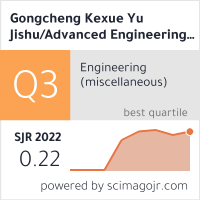Dear respected authors,
if you can't find our response then please search our mail in your spam box and communicate with us to the following mail as well: yutakaara27@gmail.com
Gongcheng Kexue Yu Jishu/Advanced Engineering Science
Gongcheng Kexue Yu Jishu/Advanced Engineering Science (ISSN: 2096-3246) is a bi-monthly peer-reviewed international Journal. Gongcheng Kexue Yu Jishu/Advanced Engineering Science was originally formed in 1969 and the journal came under scopus by 2017 to now. The journal is published by editorial department of Journal of Sichuan University. We publish every scope of engineering, Mathematics, physics.
Submission Deadline
(
Vol
56
, Issue
03
)
20 Apr 2024
Day
Hour
Min
Sec
Publish On
(
Vol
56
, Issue
03
)
30 Apr 2024
Aim and Scope
Gongcheng Kexue Yu Jishu/Advanced Engineering Science (ISSN: 20963246) is a peer-reviewed journal. The journal covers all sort of engineering topic as well as mathematics and physics. the journal's scopes are in the following fields but not limited to:
Agricultural science and engineering Section:
Electrical Engineering and Telecommunication Section:
Computer Science Section :
Civil and architectural engineering :
Mechanical and Materials Engineering :
kinematics and dynamics of rigid bodies, theory of machines and mechanisms, vibration and balancing of machine parts, stability of mechanical systems, mechanics of continuum, strength of materials, fatigue of materials, hydromechanics, aerodynamics, thermodynamics, heat transfer, thermo fluids, nanofluids, energy systems, renewable and alternative energy, engine, fuels, nanomaterial, material synthesis and characterization, principles of the micro-macro transition, elastic behavior, plastic behavior, high-temperature creep, fatigue, fracture, metals, polymers, ceramics, intermetallics.Chemical Engineering :
Food Engineering :
Physics Section:
Mathematics Section:
Latest Journals
Gongcheng Kexue Yu Jishu/Advanced Engineering Science
Full article
Gongcheng Kexue Yu Jishu/Advanced Engineering Science
Full article
Gongcheng Kexue Yu Jishu/Advanced Engineering Science
Full article
Gongcheng Kexue Yu Jishu/Advanced Engineering Science
Full article
Gongcheng Kexue Yu Jishu/Advanced Engineering Science
Full article
